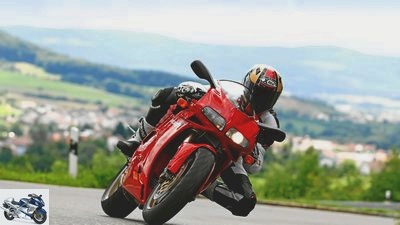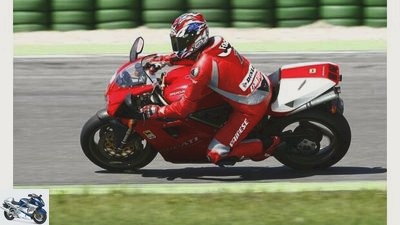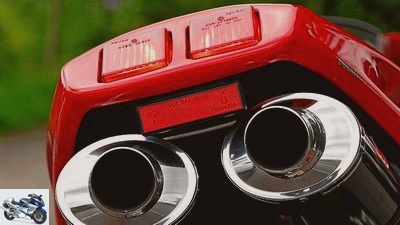Table of contents

fact
motorcycles
The readers’ dream bikes – Ducati 916
The dream bikes of the readers: Ducati 916
Classic super sports car from Ducati
No other motorcycle had previously been designed so consistently for sports use as Ducati’s 916. The professional world was delighted, the fans enthusiastic. You loved her or rejected her because of her uncompromising attitude – but she left no one indifferent.
Andreas Bildl
08/30/2012
Man, it still looks just as great today, you really should have it in the garage. ”His colleague Schmieder is over the moon. But what cools down cracking and cracking in the editorial garage is not a modern super sports rocket, but simply one Ducati 916. Indeed, even today, 17 years after their appearance, these boldly drawn cat eyes, the compact figure cast a spell over the viewer.
In 1994, the competition must have felt like Cindy Crawford had shown up at Weight Watchers. A Kawasaki ZXR 750 weighed 238 kilograms, a GSX-R 750 still 222. And the 1000s – apart from the slightly lighter Fireblade – were tough on the quarter ton. the 916 but only weighed a slim 212 kilos, looked almost even lighter and made its predecessor, the 888, look rather plump.
We stuck to the shop windows with hanging tongues, couldn’t get enough of these shapes – only to then go out into the house with our 900 SS. The 916 remained inaccessible, after all, an impressive 28,500 marks were called for it at the time. A Fireblade was available from dealers for a comparatively slim 20,000 marks.
But what did that mean compared to these gorgeous shapes? To do something like this, you had to be brilliant or insane. Or both. Exhaust under the seat, where was that something? Even if it was more due to aerodynamics than to performance or technical considerations. And a single-sided swing arm was at most the Honda RC 45. But it broke the 40,000 mark mark with ease. After all, besides the Duc, it was the only superbike that already relied on injection.
All of this gave a 916 something mythical. Above all, however, it was the dominance with which Carl Fogarty won world championship titles from now on. The 916 engine now had a stiffer and therefore more stable engine housing. Which also pleased hobby racers. Because with the 888, cracked engine housings were not uncommon in the racing trim. But the Ducati was not only a revelation for factory drivers and hobby racers. Even those who “only” took their 916 out on the country road immediately realized what a terrific achievement this motorcycle was.
Above all, it is this chassis that lifted them well above the competition. This is already evident when you go for a well-groomed ride over the house route. Even today. It has lost nothing, absolutely nothing of its charisma. The crouched figure, tachometer and water temperature gauge are framed in foam rubber, the speedometer and indicator lights can be easily removed for racing purposes. In addition, the steering damper across in front of the tank is still great today. No more, the 916 was just perfect. Just the quick-release fasteners, thanks to which it is stripped in no time at all. Anyone who has ever tried to defoliate an 888 knows what is meant. Massimo Tamburini had created his masterpiece with the 916. It was thought through down to the last detail. And it was exhausting.

fact
Ducati 916 on the racetrack.
At most one ZXR 750 subdued its driver in exactly the same way, forcing him to bow low in order to reach the handlebars. But with the 916 it is the sacrifice that the driver has to make in order to earn this unheard-of driving experience.
Even today it is still astonishing how the seating position and chassis make sense together with increasing speed, the driver, preferably with a little hanging-off in the corners, merges with the motorcycle. Fantastic, how stable the Ducati arches can be, which gives it tremendous speed in curves. And even by today’s standards, in addition to this “like-on-rails feeling”, the feedback from the roadway inspires. And: This Ducati is really tightly tuned for the country road, but without showing the unpleasant harshness of today’s superbikes at the back. So that was also possible.
But part of the fascination of this milestone also comes from the engine. Nowadays 108 hp may not tear anyone off their feet, the way in which the twin grips gently but emphatically at 2000 rpm is a stunner. His full, voluminous bollern from the end pots massages the drum and peritoneum. Not to be compared with the aggressively hard, almost painful mechanical hammering tones of a Panigale.
The 916 goes with a powerful middle, and from 5000 rpm, when it properly inflates its nostrils to willingly storm towards 10,000, with an energetic tone. It’s great how accurately it depends on the gas.
This is still great cinema today, and after a day in the saddle it leaves you with a successful but highly satisfied pilot. Made it because the 916 calls for it. When reaching for the clutch, due to the strenuous sitting position. When it comes to handling, when changing lean angles anyway – if only because of the lead-heavy three-spoke wheels. And we’d better cover the silence with the insipid brakes of the first series.
Satisfied, however, because this motorcycle offers a kaleidoscope of impressions and emotions like no other, once you have explored it. And who knows whether motorcycle history will see a 916 again. My colleague Schmieder is probably right.

fact
From then on, this rear section was the style-defining feature and template for many wild conversions.
Engine:
Water-cooled two-cylinder V-engine, bore / stroke 94.0 / 66.0 mm, 916 cm³, two overhead camshafts driven by toothed belts, four desmodromic actuated valves per cylinder, 79 kW (108 hp) at 9000 / min, 86 Nm at 7000 rpm, injection, wet sump lubrication, multi-plate dry clutch, six-speed gearbox, O-ring chain;
Landing gear:
Steel tubular frame, front upside-down fork, 43 mm, rear single-sided swing arm made of aluminum, central spring strut with lever system, front / rear tires 120/70 ZR 17, 180/55 ZR 17, double disc brake front, Ø 320 mm, four-piston fixed calipers, Single disc brake at the rear Ø 220 mm,
Weight: 212 kg with a full tank,
Top speed: 252 km / h,
price: 28,490 marks (1994)
Related articles
-
A family comparison of bikes from KTM, Ducati and Kawasaki
Rossen Gargolov motorcycles A family comparison of bikes from KTM, Ducati and Kawasaki Newcomers from KTM, Ducati and Kawasaki in a family comparison…
-
Dream bikes from the editors – please build these motorcycles
Card design by Kar Lee 8th pictures Card design by Kar Lee 1/8 Suzuki GSX 1500 Bandit. That would be something: air-cooled four-cylinder with a decent…
-
Track test Ducati 1198 S against KTM 1190 RC8 R.
Rossen Gargolov motorcycles Track test Ducati 1198 S against KTM 1190 RC8 R. Track test Ducati 1198 S against KTM 1190 RC8 R. New challenge KTM wants to…
-
Drawing: Stefan Kraft 24 pictures Drawing: Stefan Kraft 1/24 Request: Design of a BMW R 120 CS. manufacturer 2/24 Reality: Horex VR6. Drawing: Stefan…
-
Ducati Reader Experience – 15 readers test the Diavel for 2 days
Thomas Schmieder Sports & scene Events Ducati Reader Experience – 15 readers test the Diavel for 2 days Ducati reader experience Ridden the devil for a…
-
2021 large enduro bikes in comparison: Harley, BMW, KTM, Ducati
Harley-Davidson, KTM, BMW Motorrad, Ducati 16 pictures Harley-Davidson 1/16 Harley-Davidson is breaking new ground with the large enduro Pan America 1250…
-
counselor Used purchase Used advice Ducati 916 Used advice Ducati 916 Looking for a bride? With the appearance of the 996, prices for used Ducati 916s…
-
Ducati 1299 Panigale assistance systems coordinate setup
markus-jahn.com 28 pictures fact 1/28 Ducati Superbikes in a generation comparison. fact 2/28 Bite-proof and easy to dose: anchor of the 1198. ABS was…
-
Ducati motorcycles Premiere: Ducati 1098R Premiere: Ducati 1098R All’Arrabiata Content of In model year 2 of the Bologna Superbike era, the time has…
-
Comparison test: BMW R 1200 GS, Ducati Hypermotard 1100 S, KTM 990 Supermoto
Jahn motorcycles Comparison test: BMW R 1200 GS, Ducati Hypermotard 1100 S, KTM 990 Supermoto Comparison test: BMW R 1200 GS, Ducati Hypermotard 1100 S,…